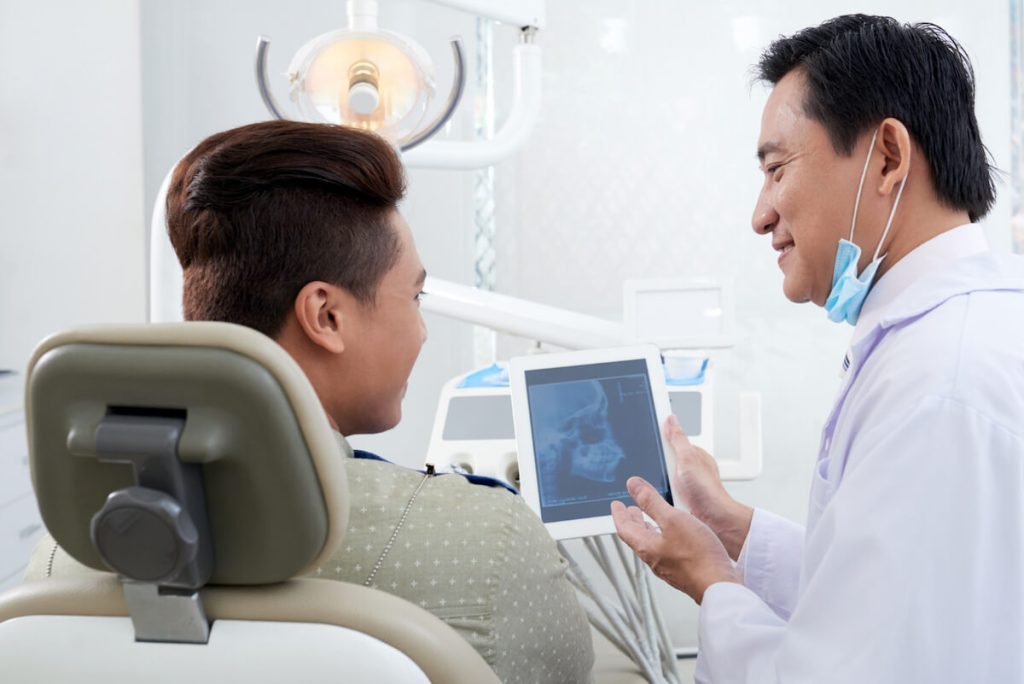Dental Bone Grafting: What It Is and What to Expect
A bone graft is a lesser-known procedure used alongside dental implant surgery to support teeth, implants, or gum disease when bone tissue is insufficient.
Bone grafts strengthen dental bone, so stabilising teeth and preventing jaw resorption.
They preserve facial profile and oral function, particularly in people with little bone tissue, preventing premature ageing.
When is a Bone Graft Necessary?
Before a dental implant can be set up, a person who has lost a tooth may require a bone graft.
Here’s why:
- In order to place a dental implant, your mouth must have enough strong natural bone. This bone must be robust and able to hold the implant.
- Resorption, or bone loss in the jaw, is common in people with missing teeth. As a result, the bone is too thin and fragile to sustain an implant.
- We can replace missing bone and supporting tissues by transplanting healthy bone tissue, laying a strong foundation for your implant.
When a tooth is lost, many people wonder how long it will take for their jawbone to regenerate.
The truth is that even if your tooth was only lost a few days ago, you could already be experiencing bone loss from other causes!
Furthermore, getting a bone transplant is not always necessary in preparation for an implant treatment or a missing tooth.
A bone graft operation can be required to stop tooth loss and other problems if you have gum disease.
Do All Patients Undergoing Dental Implant Surgery Require a Bone Graft?
No. The condition of your jawbone will determine if you require a bone graft. It’s possible that you can have an implant without needing a bone graft if you have enough strong, natural bone.
Types of Dental Bone Grafting
#1. Block Bone Graft
Your dentist will use bone from the rear of your jawbone, close to your wisdom teeth, for this sort of bone graft. If you need to address serious bone loss, this is a good alternative.
#2. Socket Graft
You can receive a socket graft at the same time as having a tooth pulled. This stops the bone loss typically brought on by adult tooth loss.
Because of the socket transplant, your body won’t be able to reabsorb the bone close to the tooth’s original location.
This maintains the readiness of your jaw for the dental implants you will receive to replace the missing tooth.
#3. Sinus Lift
If you’ve lost a few of the molars on your upper row of teeth, this bone graft may be helpful.
It’s possible that the sinuses will begin to extend lower and close the space left by the missing teeth.
A bone graft is used to close the gap, while a sinus lift returns the sinus to its original position.
Bone Grafting Procedure
Removing an old tooth to place dental implants is one of the many causes for which bone grafts may be performed.
The transplant is often performed using either sanitised donor bone or bone taken from the patient’s body, such as the jawbone or another area.
Some patients prefer this approach since there is no need for a second surgical incision.
It may take many months to implant once the graft has been completed because the bone needs time to grow new bone around the graft.
A quick recovery period is necessary after the treatment, which normally lasts within two hours.
Healing Process of Bone Graft
You might feel some discomfort following a bone graft, but it won’t be unbearable.
Ice and medicine can help you manage discomfort; your dentist may suggest treatments to lessen swelling.
It is essential to minimise swelling to prevent swelling from impairing the healing process.
Eat a healthy diet; certain medical treatments restrict liquid intake while others permit soft meals.
Sleep with your head raised to prevent blood from clotting at the surgery site and lessen swelling. Refrain from intense exercise to prevent damaging the graft site for a while.
Bone Graft at Art De Dente Melbourne CBD
Consult your dentist if you are worried that a bone graft will prevent implants or healthier teeth.
Several options are accessible nowadays, and the bone augmentation procedure can be easier than you think.
Bone grafting may be necessary in difficult situations, but only a few patients require it.
Enquire with your dentist about how a bone graft can preserve your smile.
Your Melbourne CBD dentist at Art De Dente will work closely with you to find the perfect treatment plan for you.
Call us on (03) 9642 8955 or request an appointment online.
We are located at Level 17, 190 Queen Street in Melbourne CBD.

